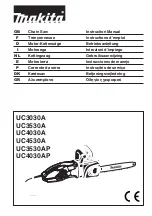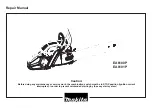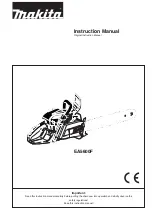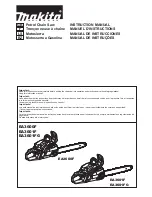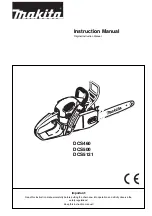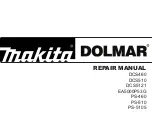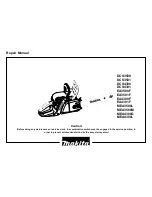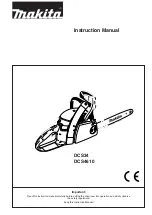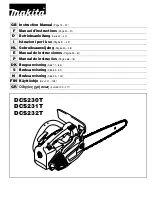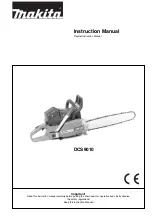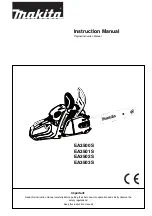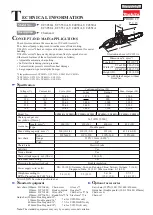
6
English
1 .
Avoid Dangerous Environment
– Don’t use appliances in
damp or wet locations.
2 .
Don’t Use In Rain.
3 .
Keep Children Away
– All visitors should be kept at a
distance from work area.
4 .
Dress Properly
–
Do not wear loose clothing or jewelry.
They can be caught in moving parts. Use of rubber gloves
and substantial footwear is recommended when working
outdoors. Wear protective hair covering to contain long hair.
5 .
Use Safety Glasses
– Always use face or dust mask if
operation is dusty.
6 .
Use Right Appliance
– Do not use appliance for any job
except that for which it is intended.
7 .
Don’t grasp the exposed cutting blades or cutting edges
when picking up or holding the appliance.
8 .
Don’t Force Appliance
– It will do the job better and with less
likelihood of a risk of injury at the rate for which it was designed.
9 .
Don’t Overreach
– Keep proper footing and balance at all times.
10 .
Stay Alert
–
Watch what you are doing. Use common sense.
Do not operate appliance when you are tired.
11 .
Disconnect Appliance
– Remove the battery when not in
use, before servicing, when changing accessories such as
blades, and the like.
12 .
Store Idle Appliances Indoors
– When not in use,
appliances should be stored indoors in dry, and high or
locked‑up place – out of reach of children.
13 .
Maintain Appliance With Care
–
Keep cutting edge sharp
and clean for best performance and to reduce the risk of injury.
Follow instructions for lubricating and changing accessories.
Inspect appliance power source periodically, and if damaged,
have it repaired by an authorized service facility. Keep handles
dry, clean, and free from oil and grease.
14 .
Check Damaged Parts
–
Before further use of the appliance,
a guard or other part that is damaged should be carefully
checked to determine that it will operate properly and perform
its intended function. Check for alignment of moving parts,
binding of moving parts, breakage of parts, mounting, and
any other condition that may affect its operation. A guard
or other part that is damaged should be properly repaired
or replaced by an authorized service center unless indicated
elsewhere in this manual.
SAVE THESE INSTRUCTIONS
WARNING ‑ Do not operate near electrical power
lines.
The unit has not been designed to provide
protection from electric shock in the event of contact with
overhead electric lines, Consult local regulations for safe
distances from overhead electric power lines and ensure
that the operating position is safe and secure before
operating the saw chain pole pruner.
•
Keep all parts of the body away from the saw chain. Do
not remove cut material or hold material to be cut when
blades are moving. Make sure the switch is off when
clearing jammed material. Blades coast after turn off.
IMPORTANT SAFETY INSTRUCTIONS
WARNING:
To reduce risk of injury:
• Before any use, be sure everyone using this unit reads
and understands all safety instructions and other
information contained in this manual.
• Save these instructions and review frequently.
WARNING:
When using electric gardening appliances,
basic safety precautions should always be followed to
reduce risk of fire, electric shock, and personal injury,
including the following.
performed.
Use of the power tool for operations different
from those intended could result in a hazardous situation.
h )
Keep handles and grasping surfaces dry, clean and
free from oil and grease.
Slippery handles and grasping
surfaces do not allow for safe handling and control of the
tool in unexpected situations.
5) Battery Tool Use and Care
a )
Recharge only with the charger specified by the
manufacturer.
A charger that is suitable for one type
of battery pack may create a risk of fire when used with
another battery pack.
b )
Use power tools only with specifically designated
battery packs.
Use of any other battery packs may create
a risk of injury and fire.
c )
When battery pack is not in use, keep it away from
other metal objects, like paper clips, coins, keys,
nails, screws or other small metal objects, that can
make a connection from one terminal to another.
Shorting the battery terminals together may cause burns
or a fire.
d )
Under abusive conditions, liquid may be ejected
from the battery; avoid contact. If contact
accidentally occurs, flush with water. If liquid
contacts eyes, additionally seek medical help.
Liquid
ejected from the battery may cause irritation or burns.
e )
Do not use a battery pack or tool that is damaged or
modified.
Damaged or modified batteries may exhibit
unpredictable behaviour resulting in fire, explosion or risk
of injury.
f )
Do not expose a battery pack or tool to fire or
excessive temperature.
Exposure to fire or temperature
above 130 °C may cause explosion.
g )
Follow all charging instructions and do not charge
the battery pack or tool outside the temperature
range specified in the instructions.
Charging
improperly or at temperatures outside the specified range
may damage the battery and increase the risk of fire.
6) Service
a )
Have your power tool serviced by a qualified repair
person using only identical replacement parts.
This
will ensure that the safety of the power tool is maintained.
b )
Never service damaged battery packs.
Service
of battery packs should only be performed by the
manufacturer or authorized service providers.
Summary of Contents for DCMASPS5
Page 1: ...DCMASPS5 ...
Page 4: ...2 7 3 Fig F 23 Fig G 24 15 23 8 7 Fig H Fig J Fig I 21 22 10 6 7 6 9 4 ...
Page 5: ...3 23 22 30 Fig K Fig L 14 6 33 22 23 Fig N Fig M ...
Page 47: ......
Page 48: ...530915 42 RUS UA 01 21 ...
























